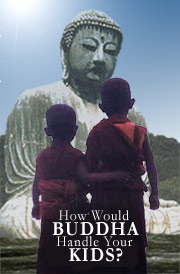How would Buddha handle your kids?
by John Bulit, (Sourced and edited from: "Frequently Asked Questions About Buddhism" by John Bullitt), The Buddhist Channel, April 14, 2005
John Bullit evokes the Ambalatthikarahulovada Sutta to elicit the five noteworthy aspects on how the Buddha effectively taught the 7-year old Rahula the Dhamma.
Kuala Lumpur, Malaysia -- The Buddha's advice to parents is straightforward - help your children become generous, virtuous, responsible, skilled and self-sufficient adults [see DN 31 and Sn II.4].
 Teaching Buddhism to one's children does not mean giving them long lectures about dependent co-arising, or forcing them to memorize the Buddha's lists of the eightfold this, the ten such-and-suches, the seventeen so-and-sos. It simply means giving them the basic skills they'll need in order to find true happiness. The rest will take care of itself.
Teaching Buddhism to one's children does not mean giving them long lectures about dependent co-arising, or forcing them to memorize the Buddha's lists of the eightfold this, the ten such-and-suches, the seventeen so-and-sos. It simply means giving them the basic skills they'll need in order to find true happiness. The rest will take care of itself.
The single most important lesson parents can convey to their children is that every action has consequences. Each moment presents us with an opportunity, and it is up to us to choose how we want to think, speak, or act. It is these choices that eventually determine our happiness. This is the essence of kamma, the basic law of cause and effect that underlies the Dhamma. It also happens to be the message behind one of the few recorded teachings the Buddha gave to his only child, Rahula.[1] This sutta - the Ambalatthikarahulovada Sutta (MN 61) - offers parents some important clues about teaching Dhamma to young children - in terms of both the content of what to teach and the method to use.
In this sutta the Buddha reprimands the seven year old Rahula for telling a small lie. The content (and intent) of the Buddha's lesson here is clear and simple: it concerns right speech, and helping Rahula keep himself true to the fundamental principles of virtue.
There are several noteworthy aspects to the Buddha's method. First, by artfully drawing comparisons to an everyday utensil (in this case, a water dipper), the Buddha makes his point in vivid and age-appropriate language that Rahula can easily understand.
Second, the Buddha doesn't launch into a long-winded abstract lecture on the nature of kamma, but instead keeps the lesson focused on the immediate issue at hand: choosing your actions carefully.
Third, although the five precepts do indeed constitute the fundamental framework for moral conduct, the Buddha does not mention them here - presumably because some of the precepts (concerning sexuality and using intoxicants) are simply not relevant to most seven year olds. (Perhaps the Buddha had more to say about the precepts by the time Rahula was a teenager.)
Fourth, the Buddha keeps Rahula engaged during the lesson by asking him simple questions; this is no dry, soporific lecture.
And finally, the Buddha takes advantage of the opportunity presented by this "teaching moment" to expand into deeper territory, to explain to Rahula the importance of reflecting inwardly before, during, and after performing an action of any sort - whether of body, speech, or mind. The Buddha thus places Rahula's original small misdeed into a much broader context, transforming it into a lesson of deep and lasting significance.
Although most of us who are parents can only dream of teaching our children as consciously and effectively as the Buddha did, we can still learn from his example. But before we can translate his example into action, there is one crucial point to recognize: the Buddha's instructions to his son were given by someone who really knew what he was talking about; Rahula's teacher was someone who truly practiced what he preached, a role model par excellence.
So the message is clear: if we hope to instruct our children about matters concerning the path of Dhamma, we had better be sure that we ourselves are practicing on that path. If you extol the virtues of skillful qualities such as generosity, truthfulness, and patience, but your children only see you being stingy, overhear you telling lies, or see you losing your temper, then your message will be lost.
Of course, you need not have perfected the Dhamma in order to instruct your children, but for your instruction to carry any weight your children must be able to witness firsthand that you are earnestly striving to put these same teachings into practice yourself. And if you can inspire them by your example and give them the skills they need to know to live in tune with the Dhamma, then you've given them a rare gift indeed.
The wise
hope for a child
of heightened or similar birth,
not for one
of lowered birth,
a disgrace to the family.
These children in the world,
lay followers,
consummate in virtue, conviction;
generous, free from stinginess,
shine forth in any gathering
like the moon
when freed from a cloud. [Iti 74]

 Teaching Buddhism to one's children does not mean giving them long lectures about dependent co-arising, or forcing them to memorize the Buddha's lists of the eightfold this, the ten such-and-suches, the seventeen so-and-sos. It simply means giving them the basic skills they'll need in order to find true happiness. The rest will take care of itself.
Teaching Buddhism to one's children does not mean giving them long lectures about dependent co-arising, or forcing them to memorize the Buddha's lists of the eightfold this, the ten such-and-suches, the seventeen so-and-sos. It simply means giving them the basic skills they'll need in order to find true happiness. The rest will take care of itself.